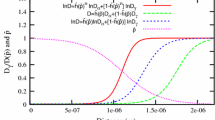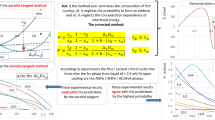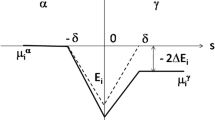Abstract
Under carefully chosen conditions, solidification theory may be applied to solid-state transformations, and this has been done here for composition-invariant diffusion transformations. The predictions of the modeling are compared with isovelocity experiments in two iron systems, Fe-7.29 wt pct Cr and Fe-3.1 wt pct Ni. The ferrite to austenite phase transformation is used to demonstrate that stabilization of a planar transformation front at absolute stability is the natural lower velocity limit for a composition-invariant (massive) transformation. The results of the model, which includes nonequilibrium effects, clearly show that steady-state plane-front growth leading to composition invariance can be obtained at various temperatures depending on the growth velocity. In the lower velocity range, at the limit of absolute stability (of the order of 10 µm/s in the systems studied), the transformation interface moves under conditions of local equilibrium, and the temperature corresponds to the lower solvus temperature. At higher velocity (of the order of the interface diffusion rate, which in these systems is of the order of cm/s), the transformation is predicted to proceed at temperatures close to T 0. At even higher rates, atom attachment kinetic undercooling will decrease the transformation temperature with respect to T 0. In some cases, this temperature might even drop below the lower solvus.
Similar content being viewed by others
References
T.B. Massalski, J.H. Perepezko, and J. Jaklovsky: Mater. Sci. Eng., 1975, vol. 18, p. 193.
J.H. Perepezko: Metall. Trans. A, 1984, vol. 15A, p. 437.
J.H. Perepezko and T.B. Massalki: Acta Metall., 1975, vol. 23, p. 621.
M. Hillert: Metall. Trans. A, 1984, vol. 15A, p. 411.
M. Hillert and M. Schalin: Acta Mater., 2000, vol. 48, p. 461.
A. Borgenstam and M. Hillert: Acta Mater., 2000, vol. 48, p. 2765.
M. Hillert: in The Mechanism of Phase Transformations in Crystalline Solids, Institute of Metals Monograph No. 33, Institute of Metals, London, 1969, p. 231.
W. Kurz and M. Lima: Proc. Int. Conf. Solid-Solid Phase Transformations, The Japan Institute of Metals, Kyoto, Japan, 1999, p. 1581.
R. Trivedi and W. Kurz: Int. Mater. Rev., 1994, vol. 39, p. 49.
P. Gilgien and W. Kurz: Mater. Sci. Eng., 1994, vol. A178, p. 199.
W.A. Tiller, K.A. Jackson, J.W. Rutter, and B. Chalmers: Acta Metall., 1953, vol. 1, p. 428.
W.J. Boettinger and S.R. Coriell: Science and Technology of the Undercooled Melt, NATO ASI Series 114, P.R. Sahm, H. Jones, and C.M. Adams, eds., NATO, Dordrecht, Netherlands, 1986, p. 81.
M.J. Aziz: J. Appl. Phys., 1982, vol. 53, p. 1158.
M.J. Aziz and T. Kaplan: Acta Metall., 1988, vol. 36, p. 2335.
M.J. Aziz: Metall. Mater. Trans. A, 1996, vol. 27A, p. 671.
W. Kurz, B. Giovanola, and R. Trivedi: Acta Metall. Mater., 1986, vol. 34, p. 823.
W Kurz and D.J. Fisher: Fundamentals of Solidification, 4th ed., Trans Tech Publications, Aedermannsdorf, Switzerland, 1998, p. 247.
W.W. Mullins and R.F. Sekerka: J. Appl. Phys., 1989, vol. 35, p. 444.
D.A. Huntley and S.H. Davis: Acta Metall. Mater., 1993, vol. 41, p. 2025.
M. Carrard, M. Gremaud, M. Zimmermann, and W. Kurz: Acta Metall. Mater., 1992, vol. 40, p. 983.
W. Kurz and R. Trivedi: Metall. Mater. Trans. A, 1996, vol. 27A, p. 625.
D. Turnbull: J. Phys. Chem., 1962, vol. 66, p. 609.
M. Vandyoussefi, H.W. Kerr, and W. Kurz: Acta Mater., 1997, vol. 45, p. 4093.
M. Sumida and W. Kurz: EPFL, Lausanne, unpublished research 2001.
Author information
Authors and Affiliations
Additional information
This article is based on a presentation made at the symposium entitled “The Mechanisms of the Massive Transformation,” a part of the Fall 2000 TMS Meeting held October 16–19, 2000, in St. Louis, Missouri, under the auspices of the ASM Phase Transformations Committee.
Rights and permissions
About this article
Cite this article
Lima, M., Kurz, W. Massive transformation and absolute stability. Metall Mater Trans A 33, 2337–2345 (2002). https://doi.org/10.1007/s11661-002-0357-1
Issue Date:
DOI: https://doi.org/10.1007/s11661-002-0357-1




